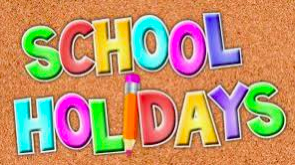9 Media Studies 2
Section outline
-
-
Students are to use their creative and technical skills to combine juxtaposing skills and photo editing using GIMP open source software package to capture a day in the life of a MHJC student.
-
-
EXPLORE / TŪHURA learning intentions:
- We are EXPLORING media production by developing and communicating ideas through the development of skills in the use of media technology.
- We are EXPLORING the impact of media by investigating the use language, symbols, and structures to create meaning.
- We are EXPLORING by experimenting with photo editing through GIMP
- We are EXPLORING analysing how photographers use juxtaposition for increased impact
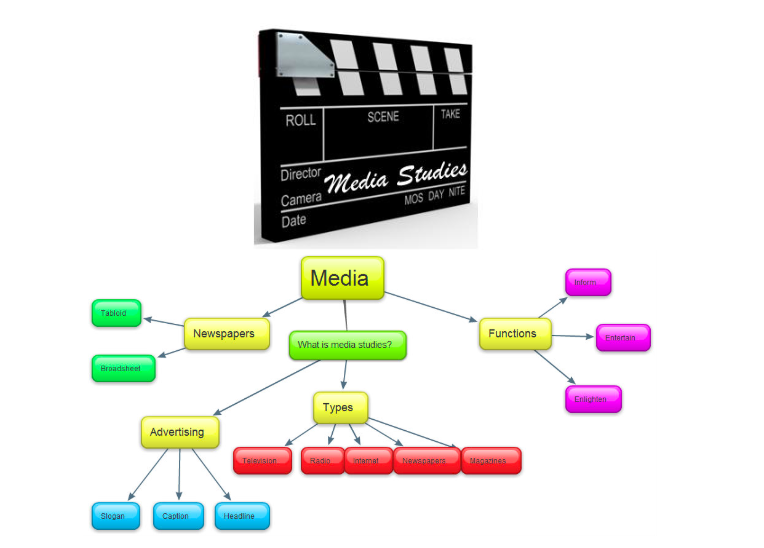
Do Now:
Who said "The only way to get rid of my fears is to make films about them."?
Once you have found the person who said the quote above - remember at least ONE fact about them.
Part 1:
Think about opportunities, convenience, entertainment, sourcing information and creating it.
How has the internet made things better?
How many different ways can you think of that the internet has improved your lives or the lives of others, and can you give practical examples/services that demonstrate this?
Part2:
Everything that we to post, search, like, leaves a trail behind of information people can find out about us on line. It is important for us to remember that your conduct plays a big part in how others may perceive you online. Being perceived positively could provide you with opportunities in the future, particularly when it comes to pursuing further education or job hunting.
What can you do to make the internet a better place?
Part 3
Go through the Photoshop tutorial - you next task is to take your own photo and to edit it using Photoshop.
Class debate:
Resources:Websites and services that allow you to communicate anonymously have made the internet a better place.
https://www.hongkiat.com/blog/41-nicest-photoshop-photo-effects-photoshop-tutorials/
-
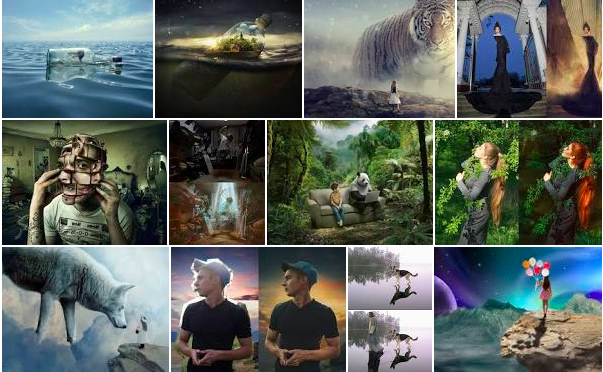
EXPLORE / TŪHURA learning intentions:
- We are EXPLORING media production by developing and communicating ideas through the development of skills in the use of media technology.
- We are EXPLORING the impact of media by investigating the use language, symbols, and structures to create meaning.
- We are EXPLORING by experimenting with photo editing through GIMP
- We are EXPLORING analysing how photographers use juxtaposition for increased impact
Students learn to make media products that can entertain, inform, and challenge. They explore, develop, and communicate ideas through the development of their skills in the use of media technology. In the process, they use language, symbols, and structures to create meaning. In reflecting on their own and others’ products, students develop their production skills.
For the purpose of Media Studies you need the GIMP software downloaded on to their computer. https://www.gimp.org/Familiarise yourself with the tutorial videos
-
-
-
Your first assessment will be on using GIMP.
-
EXPLORE / TŪHURA learning intentions:
- We are EXPLORING media production by developing and communicating ideas through the development of skills in the use of media technology.
- We are EXPLORING the impact of media by investigating the use language, symbols, and structures to create meaning.
- We are EXPLORING by experimenting with photo editing through GIMP
- We are EXPLORING analysing how photographers use juxtaposition for increased impact
This week we will continue using GIMP to manipulate a photo. This skills you learn will be later applied to an advertisement poster that I would like you to create using original images that SHOWCASES A DAY IN THE LIFE OF A MHJC STUDENT. We will also be participating in the Youth Week Poster Design Competition.https://arataiohi.org.nz/youth-week-2020-poster-design-competition/
DO NOW: Divide into 'Confident' and 'Developing' Gimp Skills buddies
- Confident buddy show Developing buddy how to crop out part of image-A and lay it on top of image-B
- Developing buddy have a go at doing this
IMAGE -A

IMAGE-B

-
FOCUS / ARONGA learning intentions:
- We are FOCUSING on enhancing the impact of a photograph that captures a day in the life of a MHJC student
- We are FOCUSING on selecting a range of techniques on GIMP to edit a photograph
- We are FOCUSING on explaining the choices I have made to edit my photograph
- We are FOCUSING on choosing a range of techniques to enhance an image
- We are FOCUSING on discussing the editing tools that can effectively enhance a photograph
Students will gain knowledge, skills, and experience to:
- explore media conventions and technology to create media.
Do Now:
The meaning of JUXTAPOSING is............





What are we looking or?
Focal points
Depth of filed
Lines
Balance
Feeling, effect, message
Colour Vs Black & White
-
FOCUS / ARONGA learning intentions:
- We are FOCUSING on enhancing the impact of a photograph that captures a day in the life of a MHJC student
- We are FOCUSING on selecting a range of techniques on GIMP to edit a photograph
- We are FOCUSING on explaining the choices I have made to edit my photograph
- We are FOCUSING on choosing a range of techniques to enhance an image
- We are FOCUSING on discussing the editing tools that can effectively enhance a photograph
~ CHECK POINT ~
- You have chosen 2 main focal points from each of the juxtaposing themes
- You have an overall idea of how you want the final image to look
- You have considered the composition of your image and made informed decisions on placement
-
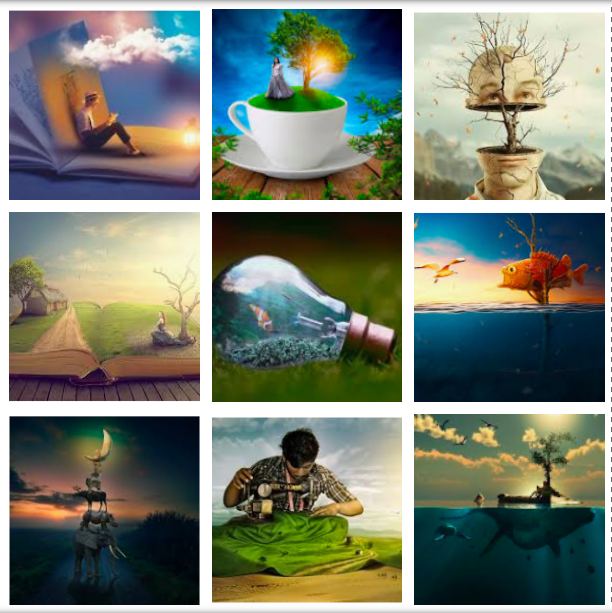
PLAN & DO / WHAKAMAHI learning intentions:
- We are PLANNING to apply the skills learned through GIMP so that we can create a photo collage displaying a day in the life of a MHJC student.
- We are PLANNING to present a photo exhibition so that we can apply our learning of teh GIMP software
This week:- Students who need to may use this session to complete and up load their Gimp image.
- You have until midnight tonight to upload the assessment - but please do not wait until then to submit your work!
- If you have finished your Gimp image and submitted it, then you are to start on the reflection sheet - up load this too as I will be reading these as well.
- Once the image is submitted and the reflection is to be up loaded
-
PLAN & DO / WHAKAMAHI learning intentions:
- We are PLANNING to apply the skills learned through GIMP so that we can create a photo collage displaying a day in the life of a MHJC student.
- We are PLANNING to present a photo exhibition so that we can apply our learning of teh GIMP software
- develop a plot for the film competition on Justice - https://www.nzonscreen.com/screentest
- create a storyboard displaying the plot
- make a film for the competition
-
REFLECT / WHAIWHAKAARO learning intentions:
- We are REFLECTING on my own and others’ products by evaluating the impact and effectiveness of the photograph
- We are REFLECTING on my own and others' products by critiquing the impact of the photograph and its impact on the audience
-
Morning all. I am assuming that you have had quality time with your families in the lockdown period. The start of this term I would like us to spend time getting our videos ready for Focus on Ability Short Film Festival. This festival asks film makers to 'Focus on the Ability' of people with a disability and tell a story on film for the world to view. The goal is to share our we can focus on the positive.
Please go through the previous years' winners - see link and all the competition details. Entries close May 29. Full details at www.focusonability.com.au
EXPLORE / TŪHURA learning intentions:
- We are EXPLORING the dynamics of movie making by collaborating on a Story Board
- We are EXPLORING dynamics of movie making by experimenting with a handheld a camera ( basics SD card - Formatting - handholding recording - capturing)
- We are EXPLORING the dynamics of movie making by recognising the process involved in film making
- We are EXPLORING the dynamics of movie by conceptualising an idea that focuses on ability
- We are EXPLORING the dynamics of movie by organising an idea into a storyboard
Success Criteria:
I can follow a number of stages to developing your story before it is ready to start shooting.
1. Basic idea, concept or story
2. Story outline without dialogue
3. Story broken into scenes
4. Script with dialogue
5. Storyboard

-
EXPLORE / TŪHURA learning intentions:
- We are EXPLORING the dynamics of movie making by collaborating on a Story Board
- We are EXPLORING dynamics of movie making by experimenting with a handheld a camera ( basics SD card - Formatting - handholding recording - capturing)
- We are EXPLORING the dynamics of movie making by recognising the process involved in film making
- We are EXPLORING the dynamics of movie by conceptualising an idea that focuses on ability
- We are EXPLORING the dynamics of movie by organising an idea into a storyboard
Success Criteria:I can follow a number of stages to developing your story before it is ready to start shooting.
1. Basic idea, concept or story
2. Story outline without dialogue
3. Story broken into scenes
4. Script with dialogue
5. Storyboard
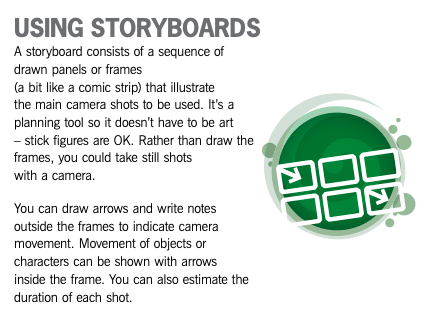
-
EXPLORE / TŪHURA learning intentions:
- We are EXPLORING the dynamics of movie making by collaborating on a Story Board
- We are EXPLORING dynamics of movie making by experimenting with a handheld a camera ( basics SD card - Formatting - handholding recording - capturing)
- We are EXPLORING the dynamics of movie making by recognising the process involved in film making
- We are EXPLORING the dynamics of movie by conceptualising an idea that focuses on ability
- We are EXPLORING the dynamics of movie by organising an idea into a storyboard
Success Criteria:
I can follow a number of stages to developing your story before it is ready to start shooting.
1. Basic idea, concept or story
2. Story outline without dialogue
3. Story broken into scenes
4. Script with dialogue
5. Storyboard

-
EXPLORE / TŪHURA learning intentions:
- We are EXPLORING the dynamics of movie making by collaborating on a Story Board
- We are EXPLORING dynamics of movie making by experimenting with a handheld a camera ( basics SD card - Formatting - handholding recording - capturing)
- We are EXPLORING the dynamics of movie making by recognising the process involved in film making
- We are EXPLORING the dynamics of movie by conceptualising an idea that focuses on ability
- We are EXPLORING the dynamics of movie by organising an idea into a storyboard
Success Criteria:
I can follow a number of stages to developing your story before it is ready to start shooting.
1. Basic idea, concept or story
2. Story outline without dialogue
3. Story broken into scenes
4. Script with dialogue
5. Storyboard

-
FOCUS / ARONGA learning intentions:
- We are FOCUSING on developing a film so that we can show a narrative that focuses on ability
- We are FOCUSING on selecting a range of visual and verbal language features so that we can enhance our film
- We are FOCUSING on choosing the most effective verbal and visual techniques that will enhance the message in the film
Success Criteria
A. Your story: What is the basic story you want to tell?
B. Narrowing the context to a specific focus, that communicates a desired outcome.
Message/focus of your film: . . . . . . . . . . . . . . . . . . . . . . . . . . . . . . . . . . . . . . . . . . . . . (eg. How might we . . . . . . . so that . . . . . . . )
C. Let's keep refining your message!
1. Suppose a member of your group or a teacher does not agree with your message. Can you solve this by writing a second message to answer his/her concerns? Reworded message/focus of your film: . . . . . . . . . . . . . . . . . .. . . . . . . . (eg. How might we . . . . . . . so that . . . . . . . )
2. Has your second message made your first message stronger or weaker? If your second message is weaker, make it stronger than the first. Reworded message/focus of your film: . . . . . . . . . . . . . . . . (eg. How might we . . . . . . . so that . . . . . . . )
3. Now you have to choose which message you want to keep. Or you could combine them if you wish.
4. Now – look at all the versions of your message. Which one is the strongest? Which one says most clearly what you want it to? Which message is the one that only you could have written? Which one best expresses your emotions?
Remember, even if your film has a close-up focus on something really personal or local, remember to consider how it fits into the bigger picture, the global effects at the wide-angle end of the spectrum. For example, if your film is about the recent attack on your local dairy-owner, think about the bigger issues – such as racism, violence, consumerism etc. And remember your wide-angle lens also helps you look forward into the future... to how you see the future unfolding, and how you’d like to shape a more sustainable future for everyone.
D. Narrowing the context to a specific focus, that communicates a desired outcome.
Final message/focus of your film: . . . . . . . . . . . . . . . .(eg. How might we . . . . . . . so that . . . . . . . )
E. What might be possible? Develop a concept map to plan your film.
-
FOCUS / ARONGA learning intentions:
- We are FOCUSING on developing a film so that we can show a narrative that focuses on ability
- We are FOCUSING on selecting a range of visual and verbal language features so that we can enhance our film
- We are FOCUSING on choosing the most effective verbal and visual techniques that will enhance the message in the film
Success Criteria
A. Your story: What is the basic story you want to tell?
B. Narrowing the context to a specific focus, that communicates a desired outcome.
Message/focus of your film: . . . . . . . . . . . . . . . . . . . . . . . . . . . . . . . . . . . . . . . . . . . . . (eg. How might we . . . . . . . so that . . . . . . . )
C. Let's keep refining your message!
1. Suppose a member of your group or a teacher does not agree with your message. Can you solve this by writing a second message to answer his/her concerns? Reworded message/focus of your film: . . . . . . . . . . . . . . . . . .. . . . . . . . (eg. How might we . . . . . . . so that . . . . . . . )
2. Has your second message made your first message stronger or weaker? If your second message is weaker, make it stronger than the first. Reworded message/focus of your film: . . . . . . . . . . . . . . . . (eg. How might we . . . . . . . so that . . . . . . . )
3. Now you have to choose which message you want to keep. Or you could combine them if you wish.
4. Now – look at all the versions of your message. Which one is the strongest? Which one says most clearly what you want it to? Which message is the one that only you could have written? Which one best expresses your emotions?
Remember, even if your film has a close-up focus on something really personal or local, remember to consider how it fits into the bigger picture, the global effects at the wide-angle end of the spectrum. For example, if your film is about the recent attack on your local dairy-owner, think about the bigger issues – such as racism, violence, consumerism etc. And remember your wide-angle lens also helps you look forward into the future... to how you see the future unfolding, and how you’d like to shape a more sustainable future for everyone.
D. Narrowing the context to a specific focus, that communicates a desired outcome.
Final message/focus of your film: . . . . . . . . . . . . . . . .(eg. How might we . . . . . . . so that . . . . . . . )
E. What might be possible? Develop a concept map to plan your film.
-
FOCUS / ARONGA learning intentions:
- We are FOCUSING on developing a film so that we can show a narrative that focuses on ability
- We are FOCUSING on selecting a range of visual and verbal language features so that we can enhance our film
- We are FOCUSING on choosing the most effective verbal and visual techniques that will enhance the message in the film
Success Criteria
A. Your story: What is the basic story you want to tell?
B. Narrowing the context to a specific focus, that communicates a desired outcome.
Message/focus of your film: . . . . . . . . . . . . . . . . . . . . . . . . . . . . . . . . . . . . . . . . . . . . . (eg. How might we . . . . . . . so that . . . . . . . )
C. Let's keep refining your message!
1. Suppose a member of your group or a teacher does not agree with your message. Can you solve this by writing a second message to answer his/her concerns? Reworded message/focus of your film: . . . . . . . . . . . . . . . . . .. . . . . . . . (eg. How might we . . . . . . . so that . . . . . . . )
2. Has your second message made your first message stronger or weaker? If your second message is weaker, make it stronger than the first. Reworded message/focus of your film: . . . . . . . . . . . . . . . . (eg. How might we . . . . . . . so that . . . . . . . )
3. Now you have to choose which message you want to keep. Or you could combine them if you wish.
4. Now – look at all the versions of your message. Which one is the strongest? Which one says most clearly what you want it to? Which message is the one that only you could have written? Which one best expresses your emotions?
Remember, even if your film has a close-up focus on something really personal or local, remember to consider how it fits into the bigger picture, the global effects at the wide-angle end of the spectrum. For example, if your film is about the recent attack on your local dairy-owner, think about the bigger issues – such as racism, violence, consumerism etc. And remember your wide-angle lens also helps you look forward into the future... to how you see the future unfolding, and how you’d like to shape a more sustainable future for everyone.
D. Narrowing the context to a specific focus, that communicates a desired outcome.
Final message/focus of your film: . . . . . . . . . . . . . . . .(eg. How might we . . . . . . . so that . . . . . . . )
E. What might be possible? Develop a concept map to plan your film.
-
PLAN & DO / WHAKAMAHI learning intentions:
- We are PLANNING a script and storyboard so that we can prepare a narrative that will focus on ability
- We are PLANNING a script and storyboard so that we can construct various aspects of an issue and make decisions about possible actions
- We are PLANNING a script and storyboard so that participate individually and collectively in response to a community challenge
- We are PLANNING a script and storyboard so that we can create and perform a narrative that focuses on ability
- We are PLANNING a script and storyboard so that we can demonstrate our understanding of social issues
- We are PLANNING a film so that it has the intended effect on the audience
WRITING A SCRIPT
At the first stage of writing try expressing your concept as a single paragraph stating the following:
- the principal idea(s) you want to explore
- the emotions you want to evoke
- the impact you wish to have on the audience
Then set the scene. Don’t forget to include important details such as time of day, setting, and the actions of the characters in the scene.
Now write the dialogue (words) to be spoken by the characters in the story. Format your writing by skipping lines between one character speaking and a different one speaking, especially if you’re handwriting it. This will enable those reading the script to distinguish between speakers more easily. And also allow space for notes.
-
PLAN & DO / WHAKAMAHI learning intentions:
- We are PLANNING a script and storyboard so that we can prepare a narrative that will focus on ability
- We are PLANNING a script and storyboard so that we can construct various aspects of an issue and make decisions about possible actions
- We are PLANNING a script and storyboard so that participate individually and collectively in response to a community challenge
- We are PLANNING a script and storyboard so that we can create and perform a narrative that focuses on ability
- We are PLANNING a script and storyboard so that we can demonstrate our understanding of social issues
- We are PLANNING a film so that it has the intended effect on the audience
The post-production stage of your project is where all the material (video, photos, music, sound effects etc) which you’ve collected is loaded onto a computer hard-drive and edited using video editing software. There are a wide variety of visual effects, transitions, titles and font styles to choose from. Here are some ideas for post-production:
• Using archival or library footage/photos
• Editing techniques such as cuts, cross-fades, montage, slow motion, time-lapse, film-in-reverse etc • Editing camera shots, photos, maps etc into an interview sequence to illustrate visually the dialogue • Subtitles such as names, places, language translation, film-maker comments/questions etc
• Graphics such as diagrams, symbols, speech bubbles, highlighter or fudge effects
• Inter-titles ie chapters or statements between sections of the film
• Photo-montage ie a sequence of still images
• Zooming or panning across still photos
• Voice-over commentary provided by one or more people to help in story-telling, link sequences or add information to help the narrative
• Music or atmospheric sound or sound effects to contrast or complement a film sequence You can avoid copyright issues by making your own music or using copyright-free music. -
PLAN & DO / WHAKAMAHI learning intentions:
- We are PLANNING a script and storyboard so that we can prepare a narrative that will focus on ability
- We are PLANNING a script and storyboard so that we can construct various aspects of an issue and make decisions about possible actions
- We are PLANNING a script and storyboard so that participate individually and collectively in response to a community challenge
- We are PLANNING a script and storyboard so that we can create and perform a narrative that focuses on ability
- We are PLANNING a script and storyboard so that we can demonstrate our understanding of social issues
- We are PLANNING a film so that it has the intended effect on the audience
Success Criteria:
What might you do? Choice of TreatmentThe part of filmmaking when you choose your story and how you are going to tell it, is called 'The Treatment.' It is important that your choice of treatment is based on the best way to get your point across. Think about whether you want your film to be serious, humorous, sad or satirical (like Michael Moore).
Here are some worthwhile questions to ask yourself to help in making your decision:
☐ 1. Are you sharing a personal experience?
☐ 2. Are you trying to get your message across?
☐ 3. Are you trying to give a balanced, two-sided story?
☐ 4. Will you include a lot of background history or just a specific story/moment in time?
☐ 5. What equipment do you have available for use
☐ 6. What other resources do you have available i.e. equipment, people, money,
archives, access to interviewees, editing etc.?
☐ 7. How much time will you need?
There are many forms, or genres, that film can take – photo essays, animations, documentaries, scripted dramas, improvisations, advertisements, music videos, dance videos, claymations, news stories, interviews, skits, stills, mash-ups – anything imaginable that we can play on a screen!
-
PLAN & DO / WHAKAMAHI learning intentions:
- We are PLANNING a script and storyboard so that we can prepare a narrative that will focus on ability
- We are PLANNING a script and storyboard so that we can construct various aspects of an issue and make decisions about possible actions
- We are PLANNING a script and storyboard so that participate individually and collectively in response to a community challenge
- We are PLANNING a script and storyboard so that we can create and perform a narrative that focuses on ability
- We are PLANNING a script and storyboard so that we can demonstrate our understanding of social issues
- We are PLANNING a film so that it has the intended effect on the audience
Success Criteria:
What might you do? Choice of TreatmentThe part of filmmaking when you choose your story and how you are going to tell it, is called 'The Treatment.' It is important that your choice of treatment is based on the best way to get your point across. Think about whether you want your film to be serious, humorous, sad or satirical (like Michael Moore).
Here are some worthwhile questions to ask yourself to help in making your decision:
☐ 1. Are you sharing a personal experience?
☐ 2. Are you trying to get your message across?
☐ 3. Are you trying to give a balanced, two-sided story?
☐ 4. Will you include a lot of background history or just a specific story/moment in time?
☐ 5. What equipment do you have available for use
☐ 6. What other resources do you have available i.e. equipment, people, money,
archives, access to interviewees, editing etc.?
☐ 7. How much time will you need?
There are many forms, or genres, that film can take – photo essays, animations, documentaries, scripted dramas, improvisations, advertisements, music videos, dance videos, claymations, news stories, interviews, skits, stills, mash-ups – anything imaginable that we can play on a screen!
-
REFLECT / WHAIWHAKAARO learning intentions:
- We are REFLECTING on the choices we made with film so that we can review its effectiveness
- We are REFLECTING on the issues we faced in the film making process so that we can evaluate the strategies we employed to create a film
Success Criteria
select a solution from which to make a focused and effective plan of action
construct a storyboard
describe the intended effect of visual and verbal techniques used in my film
FILMING
• Run the camera for a few (5-10) seconds before and after your chosen shot. This will give you flexibility when you come to edit the shot.
• Try to use a tripod whenever you want the shot to be still or steady. Make sure the camera is level - unless you intentionally want the world to look lopsided.
• A shaky camera frame can be a real distraction. Film without the tripod only if you want to go for a
hand-held filming style.
• Frame your subject to give extra space in the direction in which they are looking or moving.
• Use a mid-shot for most interviews (frame the subject from the waist to chest up).
• Film plenty of ‘cutaways’ - detailed shots and wide shots of locations and interview settings, which will be useful when it comes to editing the film.
• Consider filming ‘noddies’ (shots of an interviewer or other people listening) immediately after an interview.
• Consider the effect of the background of a shot. Does it distract or add to the shot?
LIGHTING
• Avoid brightly lit backgrounds, direct light or places that are too dark – unless they are giving you a visual effect that you like.
• Cloudy days can be helpful because the light is even and the sun isn’t casting shadows everywhere. On a sunny day you could try shooting in the shade if shooting in the sun is causing too much contrast between light and dark.
• Try using a reflector, such as a big white board, to ‘bounce’ light into shadowed areas.
SOUND
• If you have a hand-held or lapel microphone which you can plug into the camera, use it for all interviews and dialogue. Check the microphone is working and sound levels are good. Use headphones to check.
• Attempt to have the microphone close to the subject (15-20cm).
• Avoid noisy locations.
• Check sound quality on playback.
LOW-TECH OPTIONS
People often talk about film being ‘smoke and mirrors’, a magician’s craft. All film-makers improvise, making the most of what they’ve got to create a desired effect. You don’t have to use flash equipment to make a great film. For instance:
• Use a broom as your ‘boom handle’ – to hold the microphone close to the action, just out of shot.
• Anything on wheels can give you a ‘tracking’ shot – a trolley, a bike, a car, a skate board, a wheel-barrow . . .
• For lighting there are all sorts of options – lamps, torches, car lights, candles, reflector boards .
CAMERA TECHNIQUES
The camera can be a very expressive instrument. Think about how camera movement and framing can express meaning. For example:
• A close-up of a face will cause the audience to focus on facial expression. • A wide shot draws attention to the setting.
• A shot looking down at a character may make them seem weak or vulnerable. • A tilted frame can suggest danger or an unstable world.
• A hand-held shot (a moving unsteady frame that draws attention to the camera) is often used to indicate the POV (point-of-view) of a character.
OTHER TECHNIQUES
• Tracking (moving the camera) into or away from an object
• Tracking alongside a moving object
• Panning left or right
• Tilting up or down
• Framing in close-up, mid-shot, long-shot and extreme long-shot -
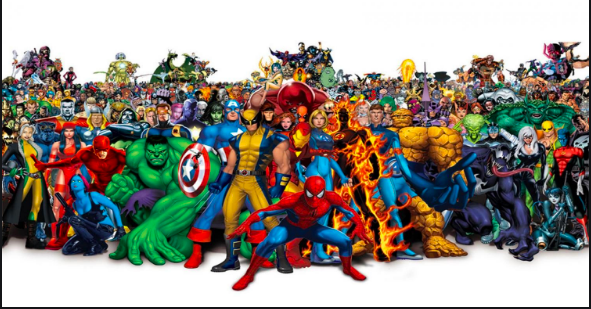
EXPLORE / TŪHURA learning intentions:
- We are EXPLORING the characteristics of superhero film genre by analysing the techniques used in these film
- We are EXPLORING the nature of superhero film genre by researching the codes and conventions of this genre
- We are EXPLORING the audience appeal of the superhero film genre by recognising that the demographics of the audience of these films is changing
- We are EXPLORING the impact of superhero film genre by classifying the historical / political context the backstory used in these film
- We are EXPLORING the success and transition of superhero film genre by conceptualising the realm of these film in popular cinema
Success Criteria - WALT:
- Identify codes and conventions of a superhero film genre
- Define genre
- Explain the impact of codes and conventions as applied to superhero film genre
Genre Definition: - Genre is a loose category or classification of a media product e.g. film. Genre acts as useful shorthand for producers, for whom it helps to generate profit and for audiences to who it provides pleasure. It helps audiences know in advance what to expect of the product and many become fans of certain genres.
The word ‘genre’ comes from the French work meaning ‘type’ or ‘class’. Media genres appear within a medium (film, television) such as the “horror” film or television “situation comedy.”
Codes and Conventions
A genre can be recognised by its common set of distinguishing features (see discussion on codes and conventions). These features associated with a genre’s style and content may be, for example, a particular setting, character types. Technical codes (lighting or music). You may find that some media texts blur genre boundaries. Audiences recognise these features and therefore expect certain things. For example, at the end of a romantic comedy film the two lead characters will realise they are in love. Audiences may even select a text on the basis of its genre. Producers market texts according to genre because a niche audience has already been identified as taking pleasure in that type of text. However, a genre is not static – it changes all the time – resulting in hybrid (or sub-genres) and changing codes and conventions. There is also a relationship between genres and the societies in which they are created.
-
EXPLORE / TŪHURA learning intentions:
- We are EXPLORING the characteristics of superhero film genre by analysing the techniques used in these film
- We are EXPLORING the nature of superhero film genre by researching the codes and conventions of this genre
- We are EXPLORING the audience appeal of the superhero film genre by recognising that the demographics of the audience of these films is changing
- We are EXPLORING the impact of superhero film genre by classifying the historical / political context the backstory used in these film
- We are EXPLORING the success and transition of superhero film genre by conceptualising the realm of these film in popular cinema
Success Criteria - WALT
- explain why the concept of genre is so important
- define how classification of films supports in marketing to a set audience
- describe how genre can be divided into sub-genre
- discuss how genre can determine narrative conventions
Why is genre important?
This term defines a category, style or type of media product as being similar in form and type. Classification of texts into genres seem to be a natural part of making sense of the cultural world. Identifying genres helps audiences to make sense of plot conventions and narrative structures.
All media products can be categorised as belonging to genres.
Genres are identified by the repetition of distinctive features.
Genres can be divided into sub-genres, for example vampire horror is a sub-genre of horror.
Genres can determine the narrative conventions of a text. Genres generate expectations in audiences.
Genres are used by producers to structure media products.
-
EXPLORE / TŪHURA learning intentions:
- We are EXPLORING the characteristics of superhero film genre by analysing the techniques used in these film
- We are EXPLORING the nature of superhero film genre by researching the codes and conventions of this genre
- We are EXPLORING the audience appeal of the superhero film genre by recognising that the demographics of the audience of these films is changing
- We are EXPLORING the impact of superhero film genre by classifying the historical / political context the backstory used in these film
- We are EXPLORING the success and transition of superhero film genre by conceptualising the realm of these film in popular cinema
SUCCESS CRITERIA
How can we identify a genre?
Genres can usually be identified through the sharing of common:
Character types
Iconography
Plots
Props
Locations
Music and soundtracks
Narratives or storyline
-
EXPLORE / TŪHURA learning intentions:
- We are EXPLORING the characteristics of superhero film genre by analysing the techniques used in these film
- We are EXPLORING the nature of superhero film genre by researching the codes and conventions of this genre
- We are EXPLORING the audience appeal of the superhero film genre by recognising that the demographics of the audience of these films is changing
- We are EXPLORING the impact of superhero film genre by classifying the historical / political context the backstory used in these film
- We are EXPLORING the success and transition of superhero film genre by conceptualising the realm of these film in popular cinema

-
FOCUS / ARONGA learning intentions:
- We are FOCUSING on superhero film genre so that we can explain the impact of the genre in mainstream media
- We are FOCUSING on superhero film genre so that we can deduce the impact of this on young people
- We are FOCUSING on superhero film genre so that we can compare the nature of the films with the comic books
- We are FOCUSING on superhero film genre so that we can describe how the codes and conventions of the genre can dictate the outcome of the film
Success Criteria:
- describe an aspect of the media genre (the aspect includes ONE of: - a change in the media genre - audience expectations and / or response to the genre - the influence of commercial considerations of the genre)
- explain how OR why the aspect has occurred / has an impact on the media genre
- examine the implication(s) and / or effect(s) of the aspect for the media genre
- include supporting evidence from at least TWO media texts and / or evidence from other sources.
The Four Ages of Comic Books: Superheroes
There are four specific ages referred to when speaking of superheroes, especially in regards to comic book superheroes, who made their first appearances in the Golden Age - in the late 1930s and early 1940s:
- The Golden Age (1936-1949) - the late 1930s to the late 40s (some say early 1950s)
This was the era of the creation of the superhero archetype, and the debut of many superhero characters, including Superman, Batman, Captain America, Captain Marvel, and Wonder Woman. After WWII, many superheroes began to decline or fade away, except for the most popular (Superman, Batman and Robin, and Wonder Woman). Comics in the early 1950s were no longer in vogue, and were replaced by other more popular literary genres: funny animal stories, teen comedies and romances, westerns, gangsters, and horror stories. This was partially due to the damaging efforts of psychiatrist Dr. Fredric Wertham, M.D., who argued in his 1954 book Seduction of the Innocent, that comic books had a deleterious effect on children, including giving kids erroneous ideas about physics (i.e., Superman could fly!), and obscenely glorifying violence and crime. - The Silver Age (1956-1969)
This was a period of revival of some older superheroes and new entries (such as the Flash, Green Lantern, Spider-Man, the Hulk, Thor, the X Men and Iron Man) and the creation of superhero teams (including the Fantastic Four and the Justice League), who were revamped, refashioned, or reintroduced, with some success. - The Bronze Age (1970-1985)
The maturing of comic-book heroes, with the appearance of some socially-relevant and timely issues, and some anti-superheroes (for example, The Punisher, Wolverine, and Ghost Rider). - The Dark Age of Comic Books (mid-1980s-present) (aka the Modern Age)
-
FOCUS / ARONGA learning intentions:
- We are FOCUSING on superhero film genre so that we can explain the impact of the genre in mainstream media
- We are FOCUSING on superhero film genre so that we can deduce the impact of this on young people
- We are FOCUSING on superhero film genre so that we can compare the nature of the films with the comic books
- We are FOCUSING on superhero film genre so that we can describe how the codes and conventions of the genre can dictate the outcome of the film
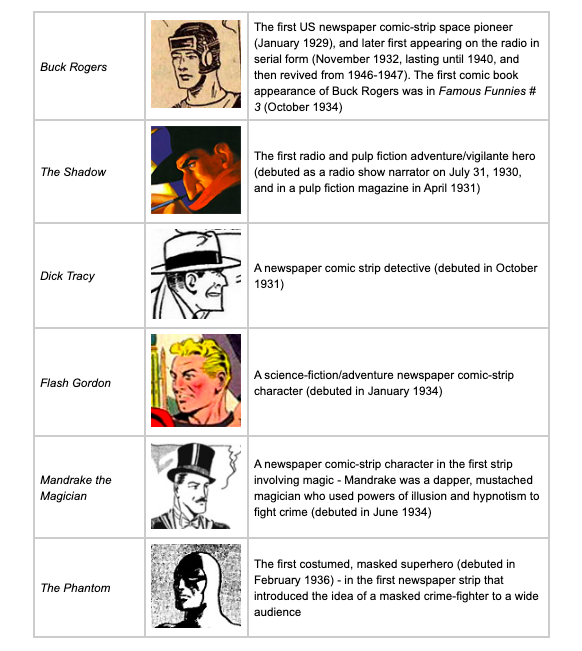
-
PLAN & DO / WHAKAMAHI learning intentions:
- We are PLANNING a research report so that we can apply our understanding of the codes and conventions of the superhero film genre
- We are PLANNING a presentation and using the GREAT Ako research process to demonstrate how the superhero film genre is impacting the modern users of media
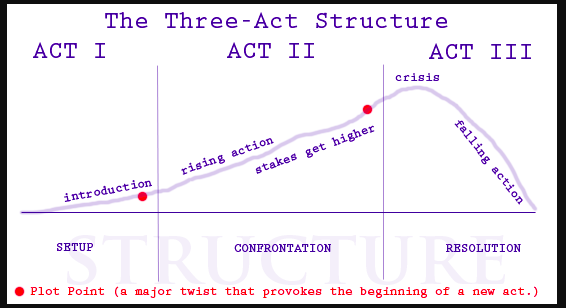
-
Trailer to watch
DO NOW
Task1: Individually list a minimum of 5 questions to ask when you want to test someones knowledge on Movie Trailers
Task 2: Find a buddy
Task 3: Open BOTH of your movie trailer questions
Task 4: Buddy up with another pair to help each other with the filming
Task 5: Watch 'Setting up and interview clip' with whole class in M8
Task 5: Decide which pair will go first
Task 6: Set up interview and practice asking and answering your questions from the Do Now
Task 7: Have one person sit down as the interviewee and ask them your questions from the Do Now (make sure your lighting is good, framing is good and they are talking off camera to the interviewer)
Task 8: Rotate so every one you are working with gets a turn at being interviewed
FOCUS / ARONGA learning intentions:
- We are FOCUSING on developing a film so that we can show a narrative that focuses on ability
- We are FOCUSING on selecting a range of visual and verbal language features so that we can enhance our film
- We are FOCUSING on choosing the most effective verbal and visual techniques that will enhance the message in the film
-
Class Activity:
In your group look at the document or website and find out as much information as you can about what the competition is about.
What are the learning opportunities for students, what are the values are of the competition, what will students have to produce to enter the competition and what is the cut off date and any other relevant dates that might be important. Look at the ministry of education site for term dates to see if it is possible to enter.
There are TWO activities for you to choose from today:
1. discover what the features of a Movie Trailer are
2. design and create a digital movie poster using a digital tool of your choice


-
Week 1 - Students to research Movie Posters. I have added useful links on Google classroom and Mission Heights online. - all learning intentions and success criteria here
Sources
https://medium.com/art-science/the-making-of-7-iconic-movie-posters-1deec2e17e42
https://www.webdesignerdepot.com/2011/02/7-elements-of-a-great-movie-poster-design/
https://www.washingtonpost.com/graphics/2019/entertainment/oscar-nominees-movie-poster-design/
https://www.filmindependent.org/blog/guest-post-effective-indie-film-poster-design-from-the-experts/
https://medium.com/outtake/are-these-the-four-best-movie-poster-artists-ever-c7b424a91b45
-
Week 2
Kia Ora
This week we will be discussing "BAD" design.
We will look at this website 23 Movie Poster Mistakes and what we can learn from them.
LINK
https://www.companyfolders.com/blog/worst-movie-posters-design-lessons
Task
You will be using a template to re-design the movie STAR TREK The voyage home - In the Style of your chosen genre. Sci-Fi, Action, Triller, Horror, romance, Indie, Comdey etc.
The template is available on Google classroom.
Infomation
STAR TREK THE VOYAGE
HOME WILLIAM SHATNER
LEONARD NIMOY

-
Week 3
Kia Ora
The BIG Picture: The art and language of visual design.
Specific Focus: What are the basic components of a film poster?What makes a good piece of design? What is the underlying structure of a successful poster?
This week we will be analysing an existing movie poster in terms of its use of the design elements and the design principles . The poster will be from a movie called"ALL SHOOK UP"
Watch this video
Please complete the table at the bottom of this document and identify what Design Elements Design Principles are used in the “ALL SHOOK UP” Poster.
Elements are...
Line,Shape,Colour/Hue,Direction,Size,texture,value
Principles are...
Balance in design is similar to balance in physics
A large shape close to the centre can be balanced by a small shape close to the edge. A large light toned shape will be balanced by a small dark toned shape (the darker the shape the heavier it appears to be)
Gradation of size and direction produce linear perspective. Gradation of of colour from warm to cool and tone from dark to light produce aerial perspective. Gradation can add interest and movement to a shape. A gradation from dark to light will cause the eye to move along a shape.
Repetition with variation is interesting, without variation repetition can become monotonous.
If you wish to create interest, any repeating element should include a degree of variation.
Contrast is the juxtaposition of opposing elements eg. opposite colours on the colour wheel - red / green, blue / orange etc. Contrast in tone or value - light / dark. Contrast in direction - horizontal / vertical.
The major contrast in a painting should be located at the center of interest. Too much contrast scattered throughout a painting can destroy unity and make a work difficult to look at. Unless a feeling of chaos and confusion are what you are seeking, it is a good idea to carefully consider where to place your areas of maximum contrast.
Harmony in painting is the visually satisfying effect of combining similar, related elements. eg.adjacent colours on the colour wheel, similar shapes etc.
Dominance gives a painting interest, counteracting confusion and monotony. Dominance can be applied to one or more of the elements to give emphasis
Relating the design elements to the idea being expressed in a painting reinforces the principle of unity.eg. a painting with an active aggressive subject would work better with a dominant oblique direction, course, rough texture, angular lines etc. whereas a quiet passive subject would benefit from horizontal lines, soft texture and less tonal contrast.
Unity in a painting also refers to the visual linking of various elements of the work.
Design Principles
Design Elements
Evidence in the poster
Not used in this design
Size is used to suggest the importance of the two main characters.
GENRE
50’s Rock n Roll, Pop
Hairstyles, clothes,
THEME/VISUAL FEEL

